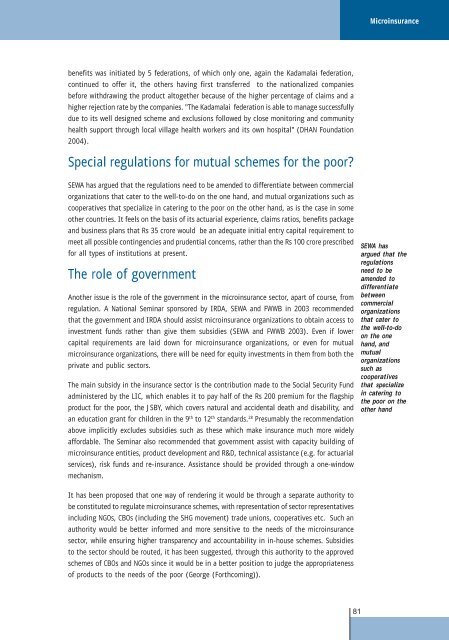Download sector_report1.pdf - Microfinance and Development ...
Download sector_report1.pdf - Microfinance and Development ...
Download sector_report1.pdf - Microfinance and Development ...
You also want an ePaper? Increase the reach of your titles
YUMPU automatically turns print PDFs into web optimized ePapers that Google loves.
Microinsurance<br />
benefits was initiated by 5 federations, of which only one, again the Kadamalai federation,<br />
continued to offer it, the others having first transferred to the nationalized companies<br />
before withdrawing the product altogether because of the higher percentage of claims <strong>and</strong> a<br />
higher rejection rate by the companies. "The Kadamalai federation is able to manage successfully<br />
due to its well designed scheme <strong>and</strong> exclusions followed by close monitoring <strong>and</strong> community<br />
health support through local village health workers <strong>and</strong> its own hospital" (DHAN Foundation<br />
2004).<br />
Special regulations for mutual schemes for the poor<br />
SEWA has argued that the regulations need to be amended to differentiate between commercial<br />
organizations that cater to the well-to-do on the one h<strong>and</strong>, <strong>and</strong> mutual organizations such as<br />
cooperatives that specialize in catering to the poor on the other h<strong>and</strong>, as is the case in some<br />
other countries. It feels on the basis of its actuarial experience, claims ratios, benefits package<br />
<strong>and</strong> business plans that Rs 35 crore would be an adequate initial entry capital requirement to<br />
meet all possible contingencies <strong>and</strong> prudential concerns, rather than the Rs 100 crore prescribed<br />
for all types of institutions at present.<br />
The role of government<br />
Another issue is the role of the government in the microinsurance <strong>sector</strong>, apart of course, from<br />
regulation. A National Seminar sponsored by IRDA, SEWA <strong>and</strong> FWWB in 2003 recommended<br />
that the government <strong>and</strong> IRDA should assist microinsurance organizations to obtain access to<br />
investment funds rather than give them subsidies (SEWA <strong>and</strong> FWWB 2003). Even if lower<br />
capital requirements are laid down for microinsurance organizations, or even for mutual<br />
microinsurance organizations, there will be need for equity investments in them from both the<br />
private <strong>and</strong> public <strong>sector</strong>s.<br />
The main subsidy in the insurance <strong>sector</strong> is the contribution made to the Social Security Fund<br />
administered by the LIC, which enables it to pay half of the Rs 200 premium for the flagship<br />
product for the poor, the JSBY, which covers natural <strong>and</strong> accidental death <strong>and</strong> disability, <strong>and</strong><br />
an education grant for children in the 9 th to 12 th st<strong>and</strong>ards. 28 Presumably the recommendation<br />
above implicitly excludes subsidies such as these which make insurance much more widely<br />
affordable. The Seminar also recommended that government assist with capacity building of<br />
microinsurance entities, product development <strong>and</strong> R&D, technical assistance (e.g. for actuarial<br />
services), risk funds <strong>and</strong> re-insurance. Assistance should be provided through a one-window<br />
mechanism.<br />
SEWA has<br />
argued that the<br />
regulations<br />
need to be<br />
amended to<br />
differentiate<br />
between<br />
commercial<br />
organizations<br />
that cater to<br />
the well-to-do<br />
on the one<br />
h<strong>and</strong>, <strong>and</strong><br />
mutual<br />
organizations<br />
such as<br />
cooperatives<br />
that specialize<br />
in catering to<br />
the poor on the<br />
other h<strong>and</strong><br />
It has been proposed that one way of rendering it would be through a separate authority to<br />
be constituted to regulate microinsurance schemes, with representation of <strong>sector</strong> representatives<br />
including NGOs, CBOs (including the SHG movement) trade unions, cooperatives etc. Such an<br />
authority would be better informed <strong>and</strong> more sensitive to the needs of the microinsurance<br />
<strong>sector</strong>, while ensuring higher transparency <strong>and</strong> accountability in in-house schemes. Subsidies<br />
to the <strong>sector</strong> should be routed, it has been suggested, through this authority to the approved<br />
schemes of CBOs <strong>and</strong> NGOs since it would be in a better position to judge the appropriateness<br />
of products to the needs of the poor (George (Forthcoming)).<br />
81














